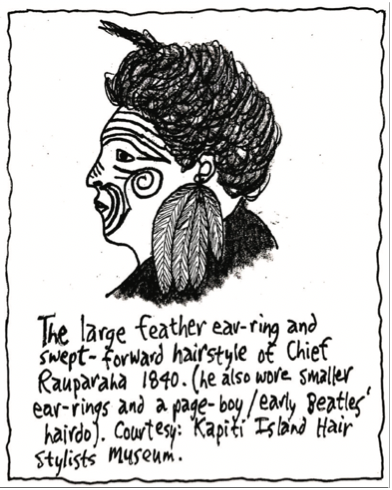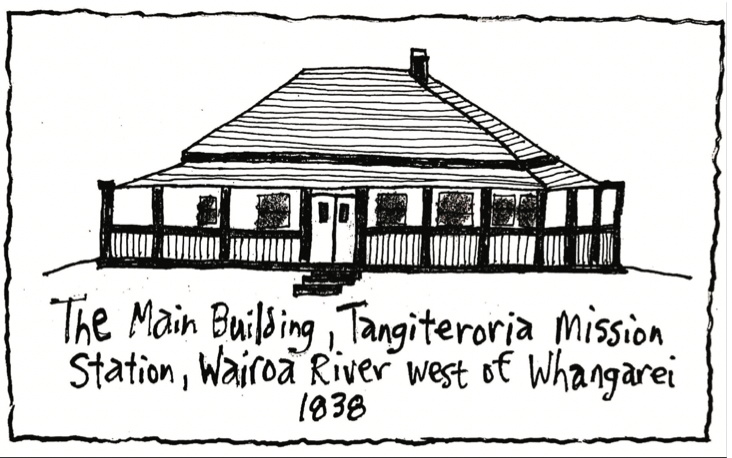Hongi Hika learns that the Rotorua Maori had supported the Waikato, Auckland and Thames Maori. So he puts his warriors and his muskets in his war canoes and paddles south again to attack the Rotorua Maori, starting with their coastal forts at Maketu and Mount Maunganui at Tauranga.
The fortress at Mount Maunganui is on top of a 760 foot high mountain reachable only by a narrow pass. Hongi defeats it by a cunning three-pronged attack. One prong goes peacefully to the fort to trade and are admitted. That night the second prong destroys all the enemy canoes on the beach, and the third prong begins scaling the mountain. When the first prong inside the fort begins attacking and setting fire to it, they are joined by the others from outside and the fort is overwhelmed.
The Rotorua Maori retreat inland to Mokoia Island in Lake Rotorua where they think they will be safe from the northern Maori. Hongi’s war party stays three days at Tauranga eating their dead enemies, and then follows them. They carry their canoes overland to Lake Rotoiti, paddle into Lake Rotorua, and then paddle around and around the island. Waiting.
On a misty morning when they could not be seen they attack Mokoia Island. The defenders rush out to the shore to stop them from landing, and are wiped out. Hongi, wearing the armoured helmet given to him by King George IV, returns north victorious again with prisoners, human heads and carved-up portions of human flesh all neatly wrapped and labelled (1823).
However Hongi is defeated twice when a siege on Matamata is abandoned when the defenders stay inside their fortress this time and weather the attack; and when the Tauranga Maori trick them by landing on Motiti Island pretending to be friendly, and then attacking them by surprise and killing all but two of them. But these are only temporary setbacks.
In 1825 Hongi Hika decides to attack the Whangarei and Kaipara Harbour Maori again. So he does. But this time they have guns too, and with 1,000 warriors outnumber Hongi’s 400. But he still succeeds in driving them south to their fortress at Te-Ika-a-ranganui, which he also attacks and destroys.

Another raid on the Waikato Maori finds them with guns as well, and they destroy Hongi’s war party at Te Rore near Hamilton. The Waikato Maori then raid north themselves and burn a missionary station at Whangaroa (1827).
When fighting yet another battle at Whangaroa (without his armour), Hongi Hika is fatally wounded, becomes paralysed, and dies in 1828.
The great warrior is dead. But the fall of one Maori chief only leads to the rise of others. When the northern Maori were the first to obtain guns and attack other Maori to the south, this had a domino effect. Tribes conquered tribes, taking their territory and scattering the survivors south. Displaced tribes then conquered and displaced other tribes. The general progression was south. In the end, it reached almost to the south end of the South Island. War disrupts the Maori world on a large scale.

Te Rauparaha is a chief of the Kawhia Harbour Maori who were attacked and displaced by the Waikato Maori, who were themselves displaced and retreating south. Te Rauparaha’s Maori are adopted by the Taranaki Maori, but when they, in turn, are attacked by the northern Maori, they both go south and attack the Palmerston North Maori who had unsuccessfully attacked the Kawhia Harbour Maori in 1822.
Now under attack themselves, the Palmerston North Maori retreat south to their fortress on artificial islands in Lake Horowhenua, where they think they are safe. But Te Rauparaha’s Maori drag their canoes overland into Lake Horowhenua, attack the Palmerston North Maori, and slaughter them. They are then attacked by the Wellington Maori who had been supporting the Palmerston North Maori and defeat them too.
Te Rauparaha realises that his tribe needs a fortress stronghold of their own if they are to survive all this attacking and counter-attacking. So he attacks and defeats the Maori on Kapiti Island who had also supported the Palmerston North Maori. They now had their stronghold. An island protected by high cliffs with few landing places.
From here Te Rauparaha becomes stronger. One thousand prisoners make flax cloth to trade to Australia for muskets. And they continue to attack other tribes. They attack north, and they attack south.
The Wanganui Maori had assisted in an attack on Kapiti Island (1829). In revenge Te Rauparaha and 1,500 warriors attack Wanganui. After laying siege for two months they offer the defenders food for peace. The defenders agree, open their fortress gates, begin eating the food, and are attacked and slaughtered. The attackers then eat the defenders.
They continue raiding south and take over new territory on both sides of the Cook Strait. On the South Island they raid south down the west coast until defeated at Tuturau (near Gore); and south down the east coast to Christchurch.
Returning north, Te Rauparaha trades a cargo of flax for the hire of a British cargo ship, loads a war party onto it, and heads back south to Akaroa, Banks Peninsula, where they massacre and loot a Maori village returning with baskets of human flesh, necklaces made of human entrails, and human hearts to send to friendly tribes as good luck omens. The next year they return south again and massacre another village (1831). But the South Island Maori reorganise themselves and push Te Rauparaha’s Maori back north to Blenheim, Cloudy Bay. Almost all of New Zealand has now been affected by Maori versus Maori war. So the next step is to look outside mainland New Zealand for somewhere else to attack.
The Chatham Islands are 450 miles east of New Zealand, and had been settled by Polynesians who had no contact with the mainland New Zealand Maori. Maori working on sealing ships however visit the Chatham Islands and learn about them, especially that they are not a very warlike people. The Maori living in Wellington who had been displaced from Taranaki by Te Rauparaha, also want a secure place to live, and when they hear about the Chatham Islands they decide that this is the place for them.
They take over a British trading ship and force it to take 900 warriors and seven war canoes to the Chatham Islands where they slaughter, eat and enslave the peaceful Chatham Islanders; before beginning to fight amongst themselves for the best land (1835).
The fortunes of Maori tribes rise and fall. They constantly make and break alliances in order to destroy one another. Deception, surprise, annihilation: this is the pattern of Maori warfare.
The missionaries promote peace between the Hokianga Harbour and Bay of Islands Maori; but wars break out between The Bay of Islands Maori themselves, and between The Bay of Islands and Whangaroa Maori.
Temporarily unable to attack the Hokianga Maori, The Bay of Islands Maori attack the Tauranga Maori instead; who then attack The Bay of Islands Maori on Mayor and Motiti islands; which leads to the Hokianga and Bay of Islands Maori both attacking the Tauranga Maori.
The Tauranga Maori and the Thames Maori form an alliance, but the Tauranga Maori spring a surprise attack on the Thames Maori at Matamata. The Tauranga Maori then join with the Waikato Maori to defeat the Thames Maori and the Auckland Maori who had joined together. In an attempt to keep the peace between the Thames and Waikato Maori, missionaries buy land between the two tribes. But peacemaking is a hopeless task.
The Tauranga Maori and the Thames Maori attack but are defeated by the Taranaki Maori. The Waikato Maori then attack the Taranaki Maori too, but are also defeated (1830-1833).
This is the way things go on in New Zealand. By 1840 the Maori had been happily slaughtering and eating each other for over 20 years with the help of guns. Most of the tribes and tribal territories are unsettled, Maori population and food production is falling, Maori disease and conversion to Christianity is rising (Bibles are more popular than playing draughts).

- Chapter One Part one: A Humorous History of NZ
- Chapter One Part two: A Humorous History of NZ
- Chapter Two Part one: NZ is Formed
- Chapter Two Part two: NZ is Formed
- Chapter Three Part One: People Come to NZ
- Chapter Three Part Two: People Come to NZ
- Chapter Four Part One: The Maori of New Zealand
- Chapter Four Part Two: The Maori of New Zealand
- The Dutch in NZ: Chapter Five Part One
- The Dutch in NZ: Chapter Five Part Two
- The British & the French in New Zealand: Chapter Five Part Three
- The British & the French in New Zealand: Chapter Five Part Four
- The British Come to New Zealand For Good: Chapter Six Part One
- The British Come to New Zealand For Good: Chapter Six Part Two
- The British Come to New Zealand For Good: Chapter Six Part Three
If you enjoyed this BFD article please consider sharing it with your friends.









